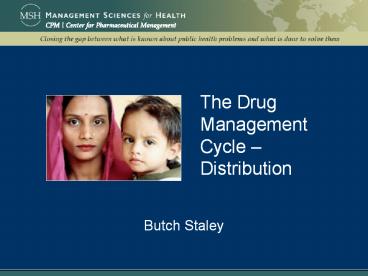The Drug Management Cycle - PowerPoint PPT Presentation
1 / 16
Title:
The Drug Management Cycle
Description:
Central Medical Stores model: South Africa, Tanzania. Autonomous supply agency: Uganda, Benin ... Central Medical Store. International Suppliers. Local ... – PowerPoint PPT presentation
Number of Views:3552
Avg rating:3.0/5.0
Title: The Drug Management Cycle
1
The Drug Management Cycle Distribution
- Butch Staley
2
(No Transcript)
3
Working Definitions
- Supply chain The network of retailers,
distributors, transporters, storage facilities,
and suppliers that participate in the sale,
delivery, and production of a product. - Logistics The overall management of the way
resources are moved to the areas where they are
required. - Distribution The delivery or giving out of an
item or items to the intended recipients.
4
Elements of the Distribution System
5
Characteristics of Effective Distribution
- Constant supply
- Maintained quality
- Minimal loss/pilferage
- Accurate and timely inventory and transaction
information - Proper storage
- Efficient transport/delivery
- Adequate geographic coverage
6
Supply System Models
- There are many models, ranging from fully public
to fully private, each with relative advantages
and disadvantages, depending on context. - Central Medical Stores model South Africa,
Tanzania - Autonomous supply agency Uganda, Benin
- Direct delivery Caribbean
- Primary distributor (prime vendor) USA
- Fully private Canada, Australia
- Mixed models Europe, Caribbean
7
Pharmaceutical Distribution Models
FULLY PRIVATE
FULLY PUBLIC
LEVELS
International
International Suppliers
National
Local Manufacturers
Central Medical Store
Local Wholesalers
Regional Medical Store
Distributors
Regional
District
District Medical Store
Private Pharmacies
Hospitals Health Centers Health Posts
Community
Users
8
Central Medical Store Model
LEVELS
PRIVATE SECTOR
PUBLIC SECTOR
International
International Suppliers
National
Local Manufacturers
Central Medical Store
Local Wholesalers
Regional Medical Store
Distributors
Regional
District
District Medical Store
Shops, Pharmacies
Hospitals Health Centers Health Posts
Community
Users
9
Direct Delivery Model
LEVELS
PRIVATE SECTOR
PUBLIC SECTOR
International
International Suppliers
National
Local Manufacturers
Central Medical Store
Local Wholesalers
Regional Medical Store
Distributors
Regional
District
District Medical Store
Shops, Pharmacies
Hospitals Health Centers Health Posts
Community
Users
10
Primary Distributor Model
LEVELS
PRIVATE SECTOR
PUBLIC SECTOR
International
International Suppliers
National
Local Manufacturers
Central Medical Store
Primary Distributor
Local Wholesalers
Regional Medical Store
Distributors
Regional
District
District Medical Store
Shops, Pharmacies
Hospitals Health Centers Health Posts
Community
Users
11
Fully Private Model
LEVELS
PRIVATE SECTOR
PUBLIC SECTOR
International
International Suppliers
National
Local Manufacturers
Central Medical Store
Local Wholesalers
Regional Medical Store
Distributors
Regional
District
District Medical Store
Private Pharmacies
Hospitals Health Centers Health Posts
Community
Users
12
Health System Supply Chain Theory
13
The Complex Reality Health Supply Chains in
Kenya
14
Key Decisions
- Key decisions include
- Push versus pull
- Centralized versus decentralized
- Roles and responsibilities public, private, NGO
- Mix of in-house and contract services
- Levels of distribution and stock requirements
15
Assessment/Option Analyses
- Understand context functionality and current
capacity of public, private, and NGO systems and
institutions - Consider variable costs with each option
- Consider capacity to manage and operate proposed
system - Define methods for monitoring and measuring
performance
16
Summary
- Designing a system for storing and distributing
pharmaceuticals is complex and important - In some countries, private (or parastatal)
distribution companies may provide cost-effective
alternatives for storage and distribution of
pharmaceuticals































